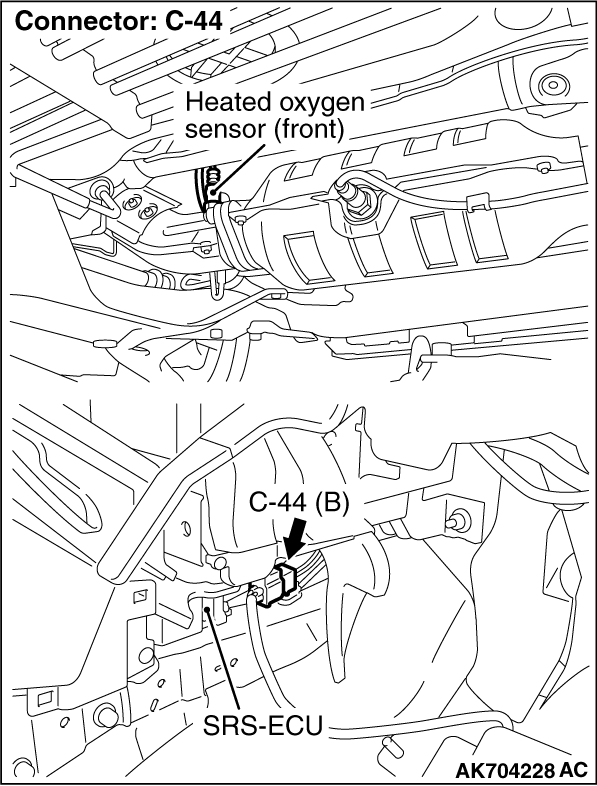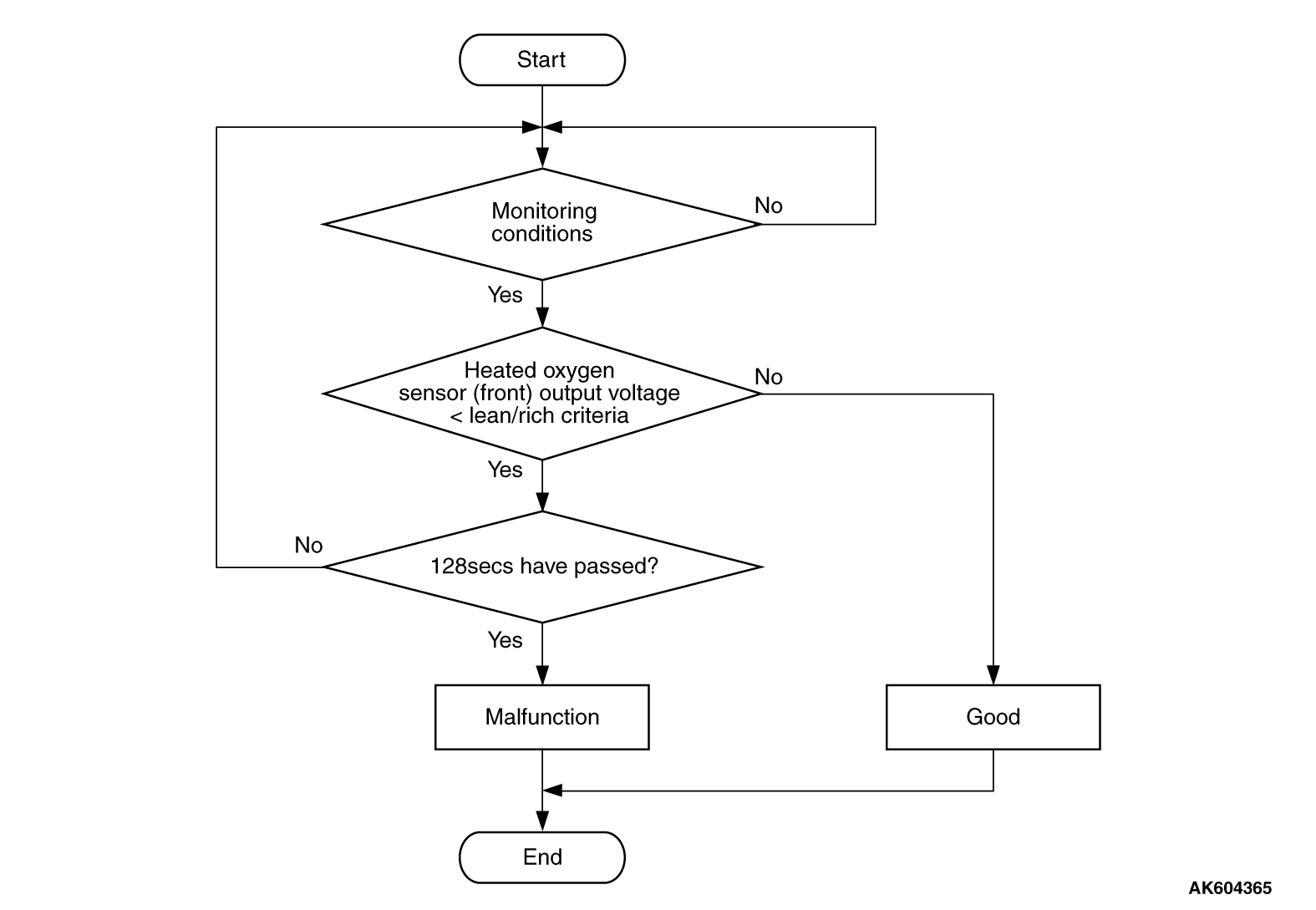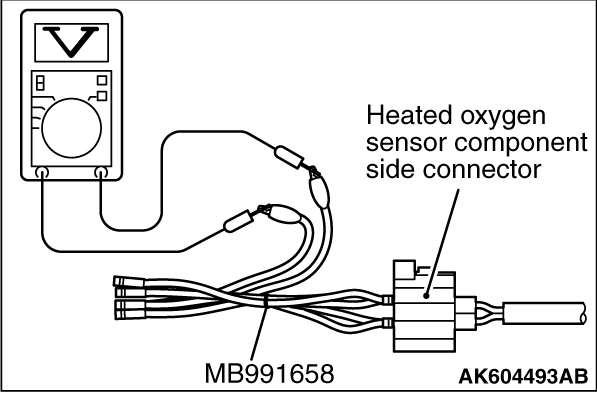![[Previous]](../../../buttons/fprev.png)
![[Next]](../../../buttons/fnext.png)
DTC P2195: Heated
Oxygen Sensor (front) Inactive

TECHNICAL DESCRIPTION
- The ECM effects air/fuel ratio feedback control
in accordance with the signals from the heated oxygen sensor (front).
- If the heated oxygen sensor (front) has deteriorated, corrections will be made by
the heated oxygen sensor (rear).
- DTC P2195 becomes stored in memory if a failure is detected in the heated oxygen
sensor (front).
DESCRIPTIONS OF MONITOR METHODS
Heated oxygen sensor (front) output voltage does not
cross lean/rich criteria (about 0.5 volt) within specified period.
MONITOR EXECUTION
MONITOR EXECUTION CONDITIONS (Other monitor and Sensor)
Other Monitor (There is no temporary DTC stored in memory
for the item monitored below)
- Heated oxygen sensor (front) heater monitor
- Misfire monitor
Sensor (The sensor below is determined to be normal)
- Engine coolant temperature sensor
- Intake air temperature sensor
DTC SET CONDITIONS
Logic Flow Chart

Check Conditions
- More than 20 seconds have passed since the engine starting sequence was completed.
- Engine coolant temperature is more than 7°C (45°F).
- Under the closed loop air/fuel ratio control.
- Intake air temperature is more than -10°C (14°
F).
Judgement Criterion
- Heated oxygen sensor (front) output voltage is less than lean/rich criteria (about
0.5 volt) for 128 seconds.
FAIL-SAFE AND BACKUP FUNCTION
OBD-II DRIVE CYCLE PATTERN
Refer to Diagnostic Function -
OBD-II Drive Cycle -
Pattern
22  .
.
TROUBLESHOOTING HINTS (The most likely causes for this code to be set are: )
- Heated oxygen sensor (front) deteriorated.
- ECM failed.
|
|
Required Special Tools:
- MB991958: Scan Tool (M.U.T.-III Sub Assembly)
- MB991824: V.C.I.
- MB991827: USB Cable
- MB991910: Main Harness A
- MB991658: Test Harness
|
|
|
STEP 1. Check the heated oxygen sensor (front).
|
|
|
(1)Disconnect the heated oxygen sensor (front) connector C-44 and connect test harness
special tool MB991658 to the connector on the heated oxygen sensor (front) side.
|
|
|
(2)Warm up the engine until engine coolant temperature reaches 80°C (176°F)
or higher.
|
|
|
(3)Rev the engine for 5 minutes or more with the engine speed of 2,000 r/min.
|

|
(4)Connect a digital voltage meter between terminal No. 3 and terminal No. 4.
(5)While repeatedly revving the engine, measure the heated oxygen sensor (front) output
voltage.
(6)Standard value: 0.6 -
1.0 V
| caution |
- Be very careful when connecting the jumper wires;
incorrect connection
can damage the heated oxygen sensor.
- Be careful the heater can be damaged if a voltage beyond 8 volts is applied to the
heated oxygen sensor heater.
|
| note |
If the temperature of sensing area does not reach the high temperature [of approximately
400°C (752°F) or more]
even though the heated oxygen sensor is normal,
the output voltage would be possibly low in spite of the rich air/fuel ratio. Therefore, if
the output voltage is low, use a jumper wire to connect the terminal No. 1 and the terminal
No. 2 of the heated oxygen sensor with the positive terminal and the negative terminal of 8
volts power supply respectively, then check again.
|
Q.
Is the measured voltage between 0.6 and 1.0 volt?
 Go to Step 2. Go to Step 2.
 Replace the heated oxygen sensor (front). Then go to Step 3. Replace the heated oxygen sensor (front). Then go to Step 3.
|
|
|
STEP 2. Check the trouble symptoms.
|
|
|
(1)Carry out a test drive with the drive cycle pattern. Refer to Diagnostic Function -
OBD-II
Drive Cycle -
Pattern 22  . .
|
|
|
(2)Check the diagnostic trouble code (DTC).
|
|
|
 Replace the ECM. When the ECM is replaced, register the ID code. Refer to GROUP
42B, Diagnosis -
ID Code Registration Necessity Judgment Table <Vehicles with KOS> Replace the ECM. When the ECM is replaced, register the ID code. Refer to GROUP
42B, Diagnosis -
ID Code Registration Necessity Judgment Table <Vehicles with KOS>  or
GROUP 42C, Diagnosis -
ID Codes Registration Judgment Table <Vehicles with WCM> or
GROUP 42C, Diagnosis -
ID Codes Registration Judgment Table <Vehicles with WCM>  .
Then go to Step 3. .
Then go to Step 3.
|
|
|
|
|
|
 It can be assumed that this malfunction is intermittent. Refer to GROUP 00, How
to Use Troubleshooting/Inspection Service Points -
How to Cope with Intermittent Malfunctions It can be assumed that this malfunction is intermittent. Refer to GROUP 00, How
to Use Troubleshooting/Inspection Service Points -
How to Cope with Intermittent Malfunctions  . .
|
|
|
|
|
|
STEP 3. Test the OBD-II drive cycle.
|
|
|
(1)Carry out a test drive with the drive cycle pattern. Refer to Diagnostic Function -
OBD-II
Drive Cycle -
Pattern 22  . .
|
|
|
(2)Check the diagnostic trouble code (DTC).
|
|
|
 Retry the troubleshooting. Retry the troubleshooting.
|
|
|
|
|
|
 The inspection is complete. The inspection is complete.
|
|
|
|
 .
.![[Previous]](../../../buttons/fprev.png)
![[Next]](../../../buttons/fnext.png)


 .
. .
. Replace the ECM. When the ECM is replaced, register the ID code. Refer to GROUP
42B, Diagnosis -
ID Code Registration Necessity Judgment Table <Vehicles with KOS>
Replace the ECM. When the ECM is replaced, register the ID code. Refer to GROUP
42B, Diagnosis -
ID Code Registration Necessity Judgment Table <Vehicles with KOS>  or
GROUP 42C, Diagnosis -
ID Codes Registration Judgment Table <Vehicles with WCM>
or
GROUP 42C, Diagnosis -
ID Codes Registration Judgment Table <Vehicles with WCM>  .
Then go to Step 3.
.
Then go to Step 3. It can be assumed that this malfunction is intermittent. Refer to GROUP 00, How
to Use Troubleshooting/Inspection Service Points -
How to Cope with Intermittent Malfunctions
It can be assumed that this malfunction is intermittent. Refer to GROUP 00, How
to Use Troubleshooting/Inspection Service Points -
How to Cope with Intermittent Malfunctions  .
. .
. Retry the troubleshooting.
Retry the troubleshooting. The inspection is complete.
The inspection is complete.